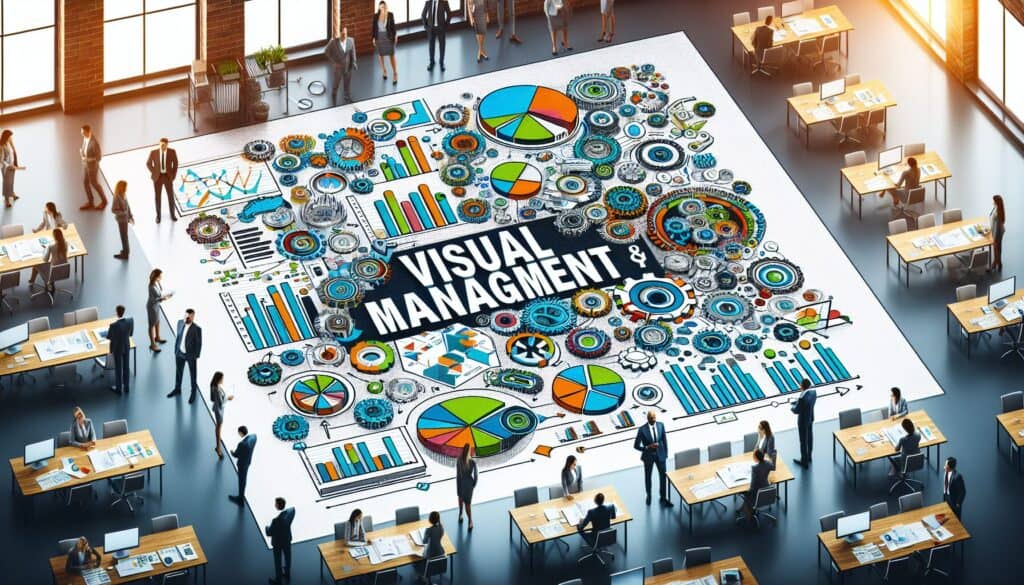Pour obtenir des informations sur les processus et les performances, normesL'objectif est de faire en sorte que les problèmes soient immédiatement visibles et facilement compréhensibles pour tous les acteurs du lieu de travail.
- Méthodologies : Ingénierie, Qualité
Gestion visuelle

Gestion visuelle
- Système Andon, Amélioration continue, Indicateur clé de performance (KPI), Production allégée, Amélioration des processus, Cartographie des processus, Contrôle de qualité, Gestion de la qualité, Conception visuelle
Objectif :
Comment il est utilisé :
- Utilise des outils visuels tels que des tableaux, des graphiques, des codes de couleur, des tableaux de bord, des tableaux d'ombres et des lampes Andon pour afficher des informations critiques en temps réel, ce qui permet d'identifier rapidement les anomalies et de faciliter une réaction rapide.
Avantages
- Améliore la communication et la transparence ; facilite l'identification rapide des problèmes et la prise de décision ; renforce l'engagement et la responsabilité des employés ; soutient la normalisation et l'amélioration continue.
Inconvénients
- Ils peuvent entraîner une surcharge d'informations s'ils ne sont pas bien conçus ou ciblés ; les visuels peuvent devenir obsolètes s'ils ne sont pas entretenus avec diligence ; ils peuvent nécessiter un investissement initial dans les affichages et le matériel ; l'efficacité dépend d'une culture de soutien qui agit sur les indices visuels.
Catégories :
- Ressources humaines, Lean Sigma, Fabrication, Gestion de projet, Qualité
Idéal pour :
- Communiquer des informations clés de manière claire et concise à l'aide de signaux visuels pour permettre une compréhension et une action immédiates sur le lieu de travail.
Visual Management is widely applicable in industries such as manufacturing, healthcare, logistics, and project management, where clear communication of processes and performance is necessary. For instance, in a manufacturing environment, shadow boards can be utilized to ensure that tools are returned to designated places, enhancing organization and efficiency on the shop floor. The use of Andon lights alerts operators and management to the status of production lines, facilitating immediate response to issues, thereby reducing downtime. In project management, dashboards can encapsulate project milestones and deadlines, enabling teams to visually track progress and make data-driven decisions quickly. This methodology thrives during phases where rapid response is needed, such as during problem-solving sessions or continuous improvement initiatives. Participants typically include team members across various levels, including frontline workers, supervisors, and management, ensuring a collaborative approach to identifying and solving abnormalities. Training in visual management techniques can further enhance employee engagement, as staff are encouraged to take ownership of their workspaces and contribute to standardization processes. This approach not only improves transparency within organizations but also encourages an environment where continuous improvement is actively pursued, leading to better performance outcomes and a more cohesive team dynamic.
Principales étapes de cette méthodologie
- Identify key performance indicators (KPIs) relevant to operations.
- Select appropriate visual tools (charts, dashboards, etc.) for displaying information.
- Design a visual layout that prioritizes clarity and immediate comprehension.
- Establish a system for real-time updates to ensure information accuracy.
- Implement color-coding or symbols to denote status and urgency.
- Train team members on interpreting visual signals and responding to them.
- Regularly review and adjust visual tools based on feedback and changing needs.
- Promote a culture where visual management is used as a standard practice.
Conseils de pro
- Incorporate real-time data inputs into dashboards, allowing for dynamic updates that reflect current conditions and drive immediate decision-making.
- Utilize color gradients and symbols on visual tools to represent data trends and variances, enabling users to quickly assess performance against benchmarks.
- Implement regular reviews and updates of visual management systems, ensuring relevancy and effectiveness in aligning with evolving objectives and processes.
Lire et comparer plusieurs méthodologies, nous recommandons le
> Référentiel méthodologique étendu <
ainsi que plus de 400 autres méthodologies.
Vos commentaires sur cette méthodologie ou des informations supplémentaires sont les bienvenus sur le site web de la Commission européenne. section des commentaires ci-dessous ↓ , ainsi que toute idée ou lien en rapport avec l'ingénierie.
Contexte historique
1986
(si la date est inconnue ou n'est pas pertinente, par exemple "mécanique des fluides", une estimation arrondie de son émergence notable est fournie)

Articles Similaires
Calculateur de METS en calories
Méta-analyse
Cartographie des messages
Diagrammes du modèle mental
Forces de poussée et de traction maximales acceptables
Planification des besoins en matériaux (MRP)